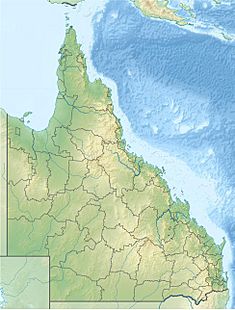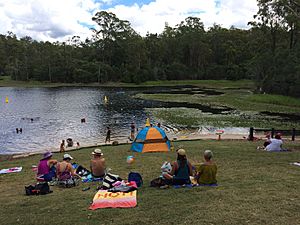Enoggera Dam facts for kids
Quick facts for kids Enoggera Dam |
|
|---|---|

Enoggera Dam, at the Brisbane Forest Park, in 2007
|
|
|
Location of Enoggera Dam in Queensland
|
|
| Country | Australia |
| Location | South East Queensland |
| Coordinates | 27°26′50″S 152°55′37″E / 27.4473°S 152.927°E |
| Status | Operational |
| Construction began | 1864 |
| Opening date | 1866 |
| Construction cost | £71,000 |
| Dam and spillways | |
| Type of dam | Clay cored earthfill dam |
| Impounds | Enoggera Creek |
| Height | 23.5 m (77 ft) |
| Length | 475 m (1,558 ft) |
| Dam volume | 360×103 m3 (13×106 cu ft) |
| Spillway type | Uncontrolled |
| Spillway capacity | 450 m3/s (16,000 cu ft/s) |
| Reservoir | |
| Creates | Enoggera Reservoir |
| Total capacity | 4,500 ML (990×106 imp gal; 1,200×106 US gal) |
| Catchment area | 33 km2 (13 sq mi) |
| Surface area | 358.15 ha (3.58 km2) |
| Maximum length | 2,376 m (7,795 ft) |
| Maximum width | 640 m (2,100 ft) |
The Enoggera Dam is a special old dam located in Brisbane, Queensland, Australia. It's found in the western suburb of Enoggera Reservoir. This dam is very important because it's listed as a heritage site, meaning it's a significant part of history.
Contents
Building the Enoggera Dam
The Enoggera Dam was built in 1866. It was constructed on the upper part of what was then called Breakfast Creek, which is now known as Enoggera Creek. This dam was the very first big dam ever built in Queensland. It was also the second major dam built in all of Australia! The first one was the Yan Yean Reservoir in Victoria, built in 1850.
The Enoggera Dam is special because it's one of the few remaining examples in Queensland of an old, working dam and water treatment system from that time. It's an earth-fill dam with a clay core, and it was designed and built by Joseph Brady.
In the early days, Brisbane had many problems with its water supply. After the Brisbane Municipal Council was created in 1860, they quickly formed a committee to deal with water. The very first water storage in Brisbane, located near where the Law Courts are today, often had dead animals and plants floating in it. This made the water very dirty.
Choosing the Right Spot
The Water Supply Committee first looked at Breakfast Creek, but they decided it was too close to the town. So, they hired an engineer named Thomas Oldham, who had experience with water supply in Melbourne. His job was to survey the area and find a solution for Brisbane's water problems.
Oldham suggested two possible places. One was on the Brisbane River near Dutton Park, but this idea was too expensive. The other place he suggested was chosen because it was where Enoggera Creek flowed out of the mountain range. The Surveyor-General, Augustus Gregory, also suggested a spot on Ithaca Creek. However, this location was not chosen because it had a very small area to collect water.
Enoggera Creek was a much better choice. It had a large area that collected water, rising high into the D'Aguilar Range. Many smaller creeks also flowed into it. The chosen spot was steep and covered in thick trees. It took eighteen months and ten different companies just to clear the land before construction could even begin!
How the Dam Was Built
The Queensland Government wasn't sure if the Council could manage building such a big dam. After asking for new plans and detailed cost estimates, a special group called the Board of Waterworks was set up to watch over the project.
The plan to build the dam was approved in May 1864. Work started in August 1864, and water began flowing into the dam by July 1866. A single large iron pipe, about 20 to 16 inches wide, carried water to Roma Street. From there, smaller pipes branched out to different parts of the town. By 1869, the pipelines stretched for a total of eighteen kilometers, providing water to about five to six thousand people.
The dam was designed with three outlet pipes instead of the usual one or two. This was a smart idea because it meant more water could be supplied if needed. It also added some safety benefits.
The dam was first expected to cost £50,000, but this amount was later increased to £65,000. By the end of 1870, more than £71,000 had been spent. Even with the new dam, the fast-growing city of Brisbane still needed more water. To solve this problem, another dam, the Gold Creek Dam, was approved in 1881.
There's a special drinking fountain in the City Botanic Gardens that celebrates the arrival of clean tap water in Brisbane.
Dry Spells and Floods
During dry periods, the water quality in both Enoggera Dam and the later-built Gold Creek Dam became a problem. The Mount Crosby Weir and pumping station helped a bit, but flooding of the Brisbane River was also an issue. It wasn't until 1912 that water from Enoggera Dam was filtered to make it cleaner.
A spillway was added to the dam in 1976. In the same year, seven meters were added to the height of the dam wall. This was done to help control floods.
The dam was officially stopped from supplying drinking water in 2003. However, in early 2006, water from Enoggera Dam was used again for drinking water in inner north-west Brisbane. This happened because a severe drought had made water levels in South East Queensland dangerously low.
What the Dam is Used for Today
The Brisbane City Council managed the dam until July 2008. Then, it was handed over to Seqwater as part of a big change in how water resources were managed across the region. In summer, the area around the dam is a popular spot for local families to cool down and have fun.
There are walking tracks in the area, and you don't need a special permit to use them. In March 2014, Seqwater released a guide that allowed water activities at the dam. These activities include swimming, canoeing, kayaking, and fishing (if you have a licence). The public recreation area is split into different zones: one for wading in the water and another for launching boats like canoes. You can get to the dam through the Walkabout Creek Wildlife Centre.
Heritage Status
The Enoggera Dam was officially added to the Queensland Heritage Register in 2007. This means it's recognized as an important historical site in Queensland.
Images for kids







